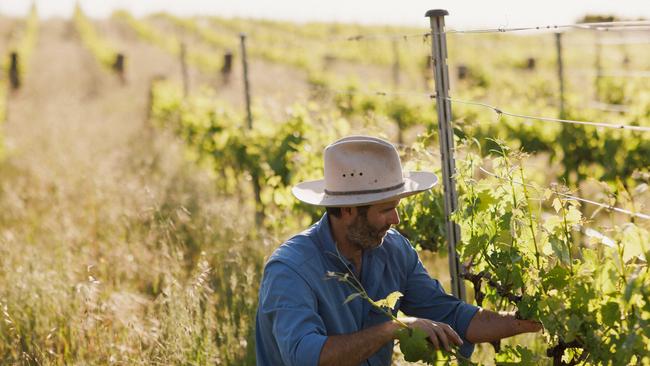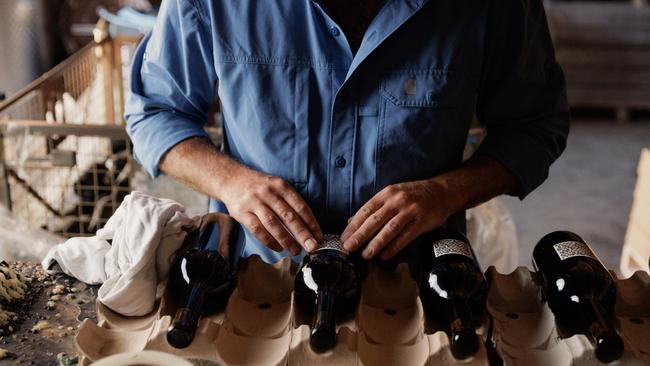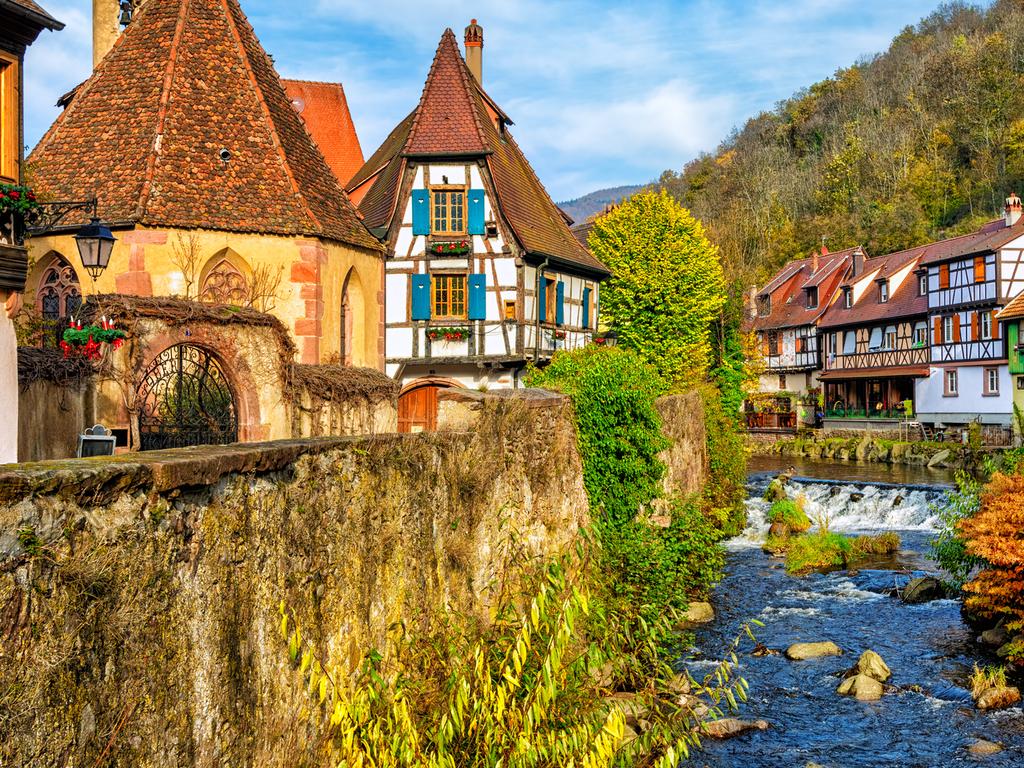Instagram is fuelling demand – and stratospheric prices – for cult wines
Fraser McKinley sells his wine for $65 a bottle. For him that's a fair price. But McKinley’s seen his bottles sell for $2500 overseas after taking off on Instagram.

Fraser McKinley is one of those laid-back, instantly likeable Kiwi blokes, strolling in bare feet and board shorts between the 140-year-old rows of vines in the famous Hoffmann family vineyard in the Barossa Valley.
He sounds almost apologetic in trying to reconcile his passion for winemaking with the hysteria that engulfs each vintage of his “Sami-Odi” shiraz – wines that provoke conniptions among feverish followers desperate to get their mitts on a bottle. Like all winemakers, he wants to share his wine with the world. But that’s simply not possible. Only a tiny fraction of those seeking a bottle of Sami-Odi will ever see one. McKinley (pictured at work, opposite) makes just 900 cases of wine a year, which he distributes to a mailing list limited to 1600 people. If you want to get on that mailing list you need to join a waitlist. Sign up now and you’ll be about number 24,000. In short, you’ve got no hope. “We love people drinking our wine,” he says. “But the reality is I won’t be able to offer most of those people any wine in my lifetime.”
They’re known in the wine game as “cult wines”, or sometimes “unicorn wines”, often denoted by a purple unicorn emoji on the Instagram posts that spruik them. Produced in limited quantities, they have legions of fans who salivate at the prospect of getting a bottle, and who are driven mad with envy every time some lucky sod flaunts on social media their good fortune to get one. Classic FOMO. And as demand soars, so does its price on online auctions and in restaurants, often to heights that leave the winemakers shocked.

McKinley makes his wine from grapes picked from the Hoffmann family’s renowned Dallwitz Block, and from a vineyard he planted at his property in the Eden Valley in 2017. He sells it for between $65-$95 a bottle. For him, it’s a more than fair price. “$75 a bottle is $100 a litre. We make wine in 20-litre buckets. So to look at that bucket and think, ‘That’s $2000 right there’, that strikes me as a lot of money.”
But that’s nothing. You’ll be doing well to nab a bottle of Sami-Odi for under $300 at an online auction, and McKinley’s seen his bottles sell for $2500 overseas. “I try not to get too carried away by it,” he says. “But it doesn’t sit well with me when people buy wine off our mailing list and then sell it to make a profit. I find it a little cynical. But that’s the reality.”
Cult wines are not new, but the way they are being hyped is changing. Two decades ago, when a young McKinley first arrived in the Barossa Valley, a handful of Australian “cult” wines were at their peak, especially in the US. The reason for their status was simple: the world’s most influential wine critic, Robert Parker, had discovered our old-vine shiraz, which he saw as Australia’s gift to the world. No endorsement was more valuable than Parker’s in those days, and Australia suddenly found itself part of a global fine-wine conversation.
One of the first winemakers championed by Parker was another Kiwi, Chris Ringland, who made a big, bold Barossa shiraz called Three Rivers. McKinley credits Ringland as a major inspiration. “He was making these mythical wines, which didn’t look like wine you’d find at the bottle shop, and only making about 1500 bottles a year. It doesn’t spread very far once the world gets excited about them.” McKinley released his first vintage of 800 bottles in 2009. It sold out in weeks. Each year the mailing list would double, until there were more people wanting wine than there was wine to sell, and the list had to close.
What has driven Sami-Odi’s stratospheric rise – other than its exceptional quality – is slightly less tangible, but no less seductive. McKinley and his wife Andrea, known as Andy, do everything themselves, painting the idealised picture of winemakers tending to their vineyards, picking grapes and making wine by hand. “I’ve stuck on every single label myself for 17 years,” he says. “Andy has assembled every cardboard box. I hope that people can taste that heart-and-soul connection.”
With eye-catching, artistic labels that change every year, and oddly-shaped bottles that look like something you might find stashed under the gunwales of a pirate ship, a bottle of Sami-Odi is instantly recognisable. But there’s another factor aiding to the Sami-Odi success, and that’s the Instagram wine influences – or “vinfluencers”, as they’ve been dubbed.
“Instagram is doing what Robert Parker did 20 years ago,” says McKinley. “It’s where the wine trend-setters are, and it’s become an integral part of the wine world. It’s the reason I get approached by people in Greece who want to import our wine, or Bermuda. It almost always comes back to Instagram.”
Sydney restaurateur and sommelier Nick Hildebrandt could likely reel off the current market price of every wine in the world. The waterfront restaurant Cirrus Dining he co-owns with chef Brent Savage was crowned Australia’s Wine List of the Year last September. Hildebrandt gets the fun job of deciding what price to put on bottles of wines that have entered the realm of the unicorn.
“A lot of craziness happened during Covid, and prices exploded,” Hildebrandt says. “Aspirational people want to be seen with certain wines, which used to be sold in stuffy auction houses to the very rich. Now the people who aspire to drink or collect them aren’t those people, it’s the cool kids.”

Hildebrandt says wines he will pay $100 for routinely fetch $900 at online auctions after taking off on social media. “So what to charge becomes a bit of a dilemma for me.”
The big players in the cult scene are usually French, he says, often from the Burgundy, Jura or Loire Valley regions. Names like Domaine Pierre Overnoy. Nicolas Faure. Jacques Selosse. Coche-Dury. “I call them Instagram wines,” says Hildebrandt. “And I don’t think the price people are paying for them is warranted.”
On the wine list at Cirrus you can buy a bottle of Jacques Selosse champagne for $1400, Arnaud Ente champagne for $4000, and a Sylvain Cathiard pinot noir for $4500. Fraser McKinley’s 2020 Sami-Odi shiraz seems a bargain at just $290.
Of course, not all these wines owe their inflated price tags to Instagram, but Hildebrandt says the platform is giving rare wines a broader audience, especially among those who perhaps haven’t been informed about the cost of living crisis, and who want to flaunt their wine purchases and/or smarts to their friends via their phones. “Wine becomes a status symbol. People want others to know they’re drinking certain wines. They want others to be jealous, and they’re falling over themselves to get these wines. It can cause problems for importers, because everybody wants them.”
Andrew Guard is one of those importers. He specialises mostly in European wine – small, family-owned vineyards that produce small quantities with big demand. He gets to decide how to allocate the increasingly hot commodity. “The concept of cult wine has been around a long time,” he says. “But people have become more invested since social media has pumped it up. There are people in the wine business who are not interested in drinking wine but are looking to turn a profit, by acquiring it and selling it on. It’s speculation. You can’t call it anything else.”
But he accepts he can’t control the market, and he concentrates on allocating wine to loyal customers who don’t just cherry-pick cult favourites. “There’s a saying, ‘You can only sell something once’. I don’t necessarily think people are gouging, they’re just charging what the market is. At the end of the day these wines have helped businesses make money after the terrible times of Covid. They’ve serviced people well.”
Wine writer Mike Bennie’s Instagram recommendations can help fast-track a small winery to cultdom. He says the democratic nature of social media has elevated certain wines to levels they would have never achieved through mainstream reporting or marketing. “Instagram and cult wine have been very friendly to each other,” he says. “There are more eyeballs on where these wines are going, which ‘vinfluencer’ is drinking them. The right people can definitely give credence to cult wines ... and they can also elevate wines that maybe shouldn’t be elevated.”
But Bennie says any correlation between social media spruiking and the skyrocketing secondary market price is a longer bow to draw. “What it has done is given what you might call avant-garde wineries a more diversified following. It’s drawn the gaze back to what’s happening in our own wine scene, and done wonders for wine consumption in Australia.”
Fellow wine commentator and vinfluencer Edward Agg agrees that Instagram is expediting exposure for a niche cohort of cult winemakers. He gets around twice the amount of engagement than usual from his 43,000 Insta followers when he posts a photo of a cult wine.
“Instagram doesn’t know the difference between a Romanée-Conti and a Yellow Tail, but it knows what’s getting more engagement,” he says. “Cult wines are getting pushed because people are engaging with them. So more people see them, which means even more people want them, so it self-proliferates.”
But some winemakers, he adds, would have become cult heroes even without Instagram hype. Like Fraser McKinley. “He’s done everything right,” says Agg. “He’s incredibly talented, he’s got fruit from the best vines in the Barossa Valley, the packaging changes every year so you’re excited about what the next bottle is going to look like as well as taste like, and it’s limited production. It’s the whole package.”
McKinley, meanwhile, is just getting on with making wine. In fact, his winery doesn’t even have an Instagram account. While the buzz might be elevated, his bare feet remain firmly planted on the ground. “Just because a lot of people are complimentary about what we do doesn’t make it good,” he says. “The only thing that can make it good is hard work.” b



